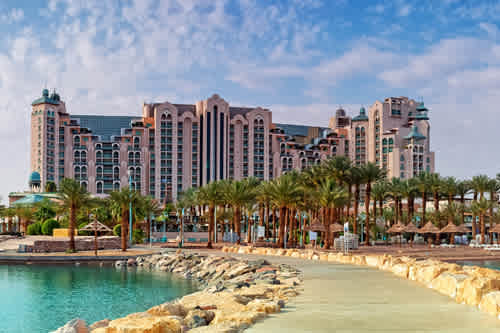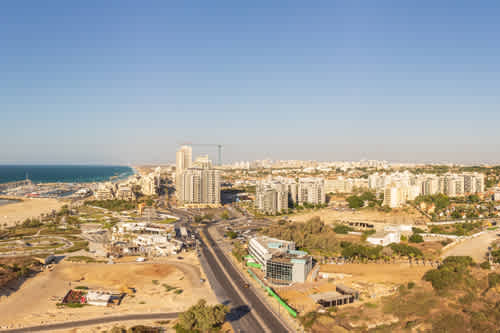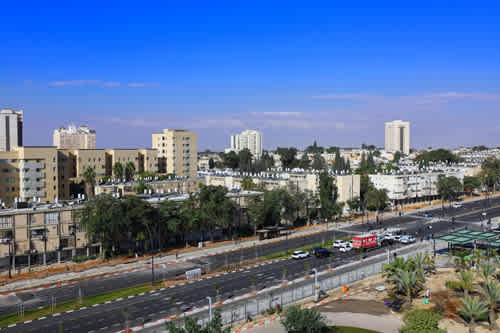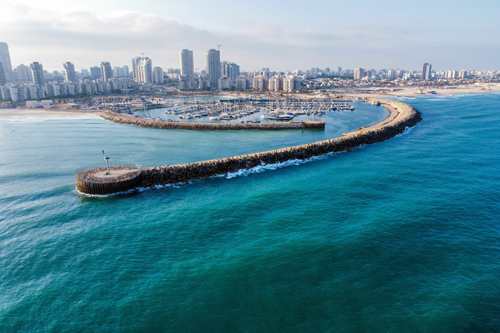Southern Israel boasts stunning beaches and resorts, dramatic and awe-inspiring landscapes, advanced desert agriculture, and a rich history.
About Southern
As you descend from the center of the country to the south, you’ll feel as if you’re leaving a narrow corridor and entering a spacious, airy room. The air is clear, the light is bright, and there are empty expanses without crowds and traffic.
At the time of the founding of the State of Israel, southern Israel had been a desolate but strategically important desert region. Today, it has become a leading economic and cultural player, both nationally and internationally.
The Negev has developed desert agriculture, finding creative solutions to the lack of water. Netafim, an international company known for its revolutionary drip irrigation, is located here as are the Dead Sea Works, Israel Chemicals, and Rotem Fertilizers – all with a significant presence around the globe.
Southern Israel is home to eight archaeological UNESCO World Heritage Sites and fascinating landscapes such as the large Ramon Craters and Kharkum Mountain.
The south extends between three beaches: The Ashkelon beach on the Mediterranean, the Dead Sea beach, and the Red Sea beaches of the southernmost city of Eilat. These beaches combine relaxation with healing and also serve as an excellent base for trips throughout the region.
There are three routes from the center of Israel to Eilat – each is full of beautiful natural sites, advanced agriculture, archeology, history, and diverse and dramatically different landscapes.
The western highway, Route 4, goes through the Philistia coast to the port city of Ashdod, a new city, the first in Israel to be built based on urban planning by private entrepreneurs. The city has a beautiful beach and marina, and, in addition to its golden, sandy beaches, Ashdod is known for its excellent restaurants and beautiful streets.
Ashkelon, located to the south, is also a new city with beautiful beaches as well as an expansive park with antiquities from the Roman period.
To the south of Ashkelon, toward the Gaza Strip, the memory of the commander of the Warsaw Ghetto uprising, Mordechai Anilowitz, was commemorated in Kibbutz Yad Mordechai. The kibbutz is home to a museum "From Holocaust to Resurrection" which tells the story of the Jewish People in the Diaspora and in Israel from the 19th century until the establishment of the modern State in 1948. It is located on the site of the Battle of 1948 which took place during the War of Independence.
Continue along the Gaza Strip to the Black Arrow Monument from where there is an amazing view of the Gaza Strip and the Separation Wall. From there, further south, there are sprawling agricultural areas that stretch to the horizon line. The crops change according to the seasons- wheat in the winter, cotton and vegetables in the summer, and the "Red South '' with blooming anemones in the spring. There is an ancient synagogue with a beautiful mosaic floor in Reim, and, continuing through the large Eshkol Park, you’ll reach the observation point, Mitzpe Revivim, on Kibbutz Revivim. The kibbutz was established in 1943, and, as a result, the Negev was included within the territory of the State of Israel in the UN Partition Plan.
From there, you will connect to Highway 40 and reach Ramat HaNegev. On the way, you can stop for a tour of the agricultural development research station located under a solar energy tower. You’ll learn about the agricultural innovations in the Negev and the use of saline water – technological expertise that is now used worldwide.
You’ll also pass areas with abundant greenhouses and solar fields and reach Shebata National Park, the site of a Nabatean city which was on the perfume road that extended from southern Arabia to the ports of the Mediterranean Sea. Although the city, a World Heritage Site, was largely destroyed, remains of houses, churches, water cisterns, and impressive walls can be clearly seen. From there, you’ll arrive at the Nitzana area on the border of Egypt, where there is an abundance of desert agriculture, mainly vegetables.
Highway 40 will lead you further south, passing by the city of Kiryat Gat and many wheat fields. In the east, you’ll see the Hebron Mountains and then the hills of Goral, leading to the capital of the south, Be'er Sheva.
At the beginning of the twentieth century, the Ottomans began to develop Be’er Sheva as a commercial and governmental center to serve three large, local Bedouin tribes- this was the only city planned by the Ottomans in their 400 years of rule in the Holy Land.
Start with a view of the city from the Negev monument designed by the artist Danny Karvan and then continue down to Tel Be'er Sheva, a World Heritage Site, and end at Be'er Avraham, where, according to tradition, Abraham, the father of the Hebrew nation, and Abimelech, the Canaanite, entered into a peace treaty.
The city is large and comprises several quarters. From a small town with a market for goats, sheep, donkeys, and camels, the city of Be’er Sheva has grown to become the ninth largest city in Israel. It is home to a university, a major hospital, and modern industrial and commercial areas.
Continue along Highway 40 through an area of low hills and dunes scattered with Bedouin tents until you reach Sde Boker. Here is where David Ben-Gurion, the first Prime Minister of Israel, lived modestly after his retirement from political life. From the balcony of his grave, there is a spectacular view of Nahal Tzin and, directly opposite, is the Ein Avdat Canyon. You can almost always see the goats and rabbits that are native to the area as well as eagles nesting in the cliffs of the gorge. This area is a national park and is a delightful place to spend a few hours.
Nearby is Avdat Nebatit, a World Heritage Site, and, further south, is Mitzpe Ramon, the town that overlooks the largest of the three Negev craters – the Ramon Crater. You can experience the crater via its walking routes or by jeep, through one of the local companies that offers organized rides. Mitzpe Ramon is also home to excellent lodging – from luxury hotels to youth hostels, or, for the more adventurous, there is Khan Saharonim in the heart of the crater, tents near the cliffs, and Bedouin tents where you can stay and learn about their way of life. Wherever you end up staying, be sure to go outside after dark and observe the sky. Israel’s largest observatory is in Mitzpe Ramon, but, even without a telescope, you can enjoy the billions of stars in the dry and clear desert air.
The road to Eilat from Mitzpe Ramon is fascinating. The views change quickly within a few minutes as do the shades and colors of nature. Naot Smadar is a green oasis in this desert with a cafe and garden, where you can find local pastries, wines, olive oil, and organic cheeses – all locally produced.
From Highway 40, you will reach Road 12 which extends along the Egyptian border through landscapes reminiscent of the surface of the moon – until you get to the colorful ridge of the Eilat Mountains. Suddenly, between the limestone and granite mountains, the Bay of Eilat appears with its blue and turquoise waters.
The road to the south on the eastern side of the Negev is equally as fascinating. Cross from Jerusalem to the Judean Desert - the desert of the Holy City – and you’ll be in the land of monasteries. During the Byzantine period, there were 62 monasteries in this area, the smallest of the world's deserts. Only three remain: Mar Saba hanging on the cliff of the Kidron River, St. George in Wadi Qelt, and St. Jerome east of Jericho. You’ll also come to one of the world’s oldest cities - Jericho. The city, located in Palestinian Authority territory, is open to tourists. In addition, you’ll pass biblical sites such as Tel Jericho which was conquered by Joshua and his army. Jericho is also the final point that Jesus reached on his last journey to Jerusalem.
Ir Ganim, the Garden City, is a large oasis and a popular vacation spot, mainly in the winter. Many of the wealthy of Jerusalem, Hebron, and Nablus built vacation homes alongside the homes of the modest locals. The city has many restaurants with nice gardens, a bustling market, and lots of fruit stalls along the roads.
Before continuing further south, stop by the Qasr al-Yahud site where, according to local tradition, John baptized Jesus in the Jordan River and where pilgrims still come to be baptized today.
From the Jordan River, continue down to Qumran, where the Dead Sea Scrolls were written and found, and then to the desert oasis of Ein Gedi. From there, head to Masada, a World Heritage Site, which was the last stronghold of Jewish freedom fighters in the great rebellion against the Romans. From Masada, take the short ride to the popular Ein Bokek bathing site. The beach is open to the public, and there are showers, deck chairs, and sun umbrellas available. Ein Bokek is home to many hotels, restaurants, and modern shopping centers and is an ideal spot for recreation as well as medical tourism. There are jeep tours available there to explore the desert cliffs above.
Continuing along the highway, you’ll pass Mount Sodom and the Dead Sea Works as you descend to the Arava on route to Eilat. Here, too, the landscapes continually change, and you’ll see date groves, greenhouses, and many fields. To the east are the Edom Mountains, and you can walk along the Peace Road adjacent to the border with Jordan. The section between Hatzeva and Ein Yahav has several spectacular observation points.
Continue along Highway 90 to Kibbutz Yatvata which is known for the famous statement of its founding members: "A kibbutz without a barn is like a violinist without a violin." Contrary to the advice of the Ministry of Agriculture experts who predicted disaster in raising cows in the heat of the desert, the members raised cows and their barn and their dairy prospered. The kibbutz is known for its dairy products, especially for its chocolate milk, and there is a café on the premises which serves up the local specialties. Then, stop for a tour of Timna National Park and the Solomon Islands before arriving in Eilat.
Which of these beautiful, interesting routes should you choose? To answer, we’ll end with the words of the poet Haim Hefer:
"Go, go to the desert
Land without water
Oh, you are my land,
We returned to you."
Come join us in exploring the wondrous desert!






